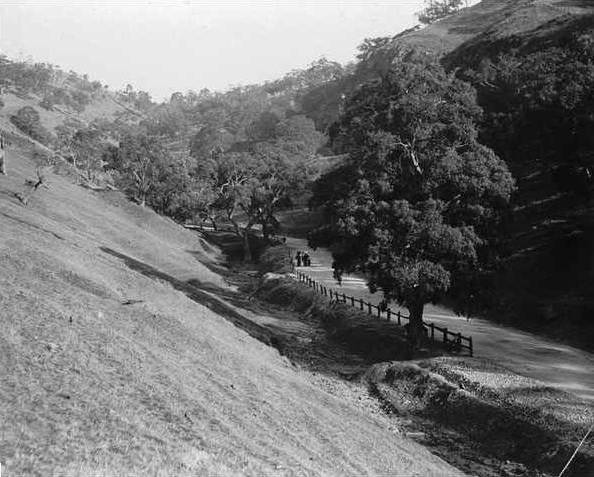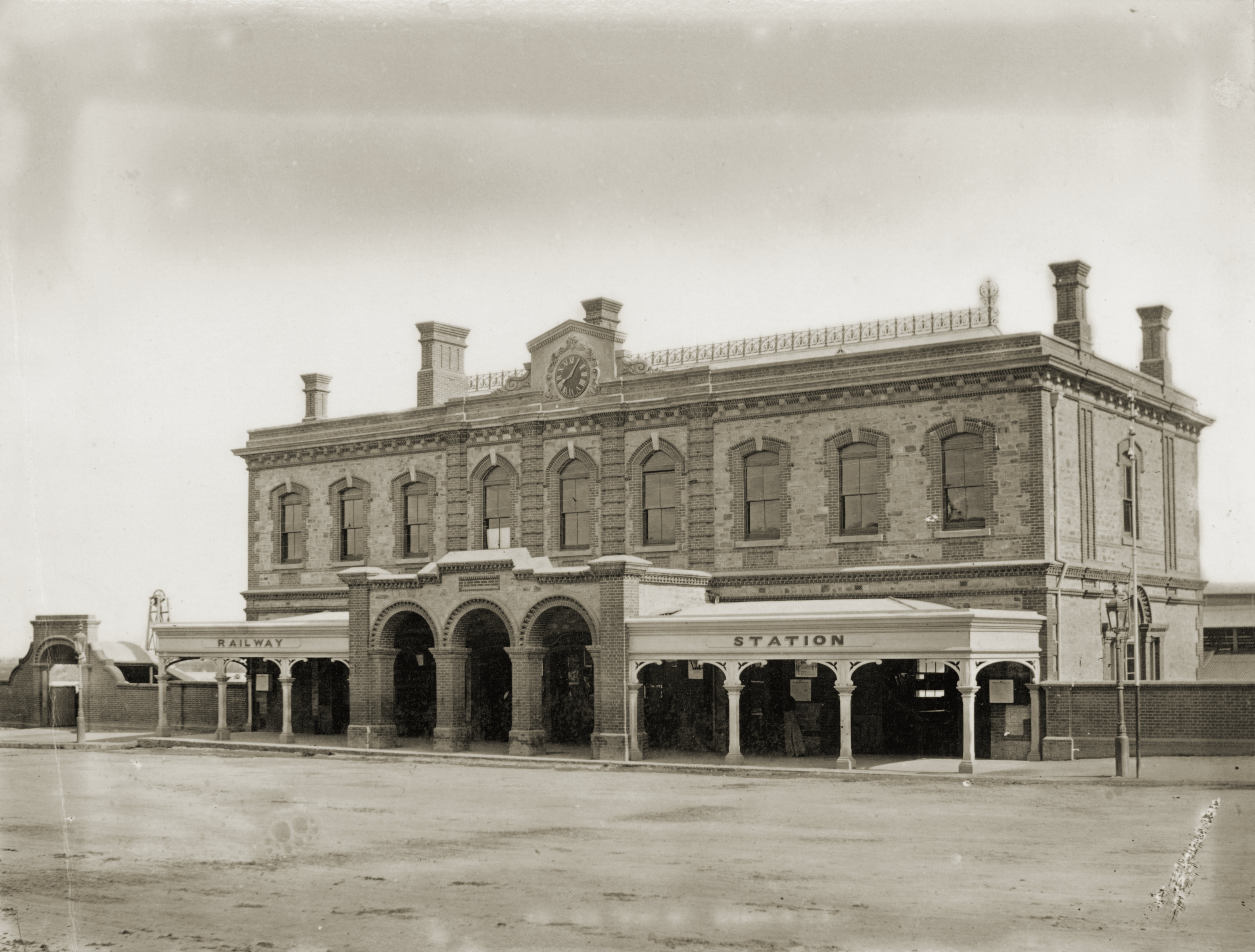|
Aldgate Railway Station, Adelaide
Aldgate railway station was located on the Adelaide-Wolseley line in the Adelaide Hills suburb of Aldgate, 34.9 kilometres from Adelaide station. History Aldgate station opened on 14 March 1883, and on 23 December 1886, a second platform was added. From 1 May 1910, most services from Adelaide station were extended to terminate at Aldgate. On 1 July 1929, the westbound platform was converted to an island platform. In 1974, the goods siding was replaced by a second crossing loop. It was very similar to Blackwood; the station building and shelter were the same. It was closed to local trains on 23 September 1987, but until 1990 was available for passengers wishing to board the Mount Gambier-bound railcar service. At the time of closure, Aldgate had three platforms. Platform 1 was a 151-metre-long side platform, and platforms 2 and 3 were a 149-metre-long island platform. The island platform was demolished in the 1990s, but the side platform remains in place, although no long ... [...More Info...] [...Related Items...] OR: [Wikipedia] [Google] [Baidu] |
Mount Barker Road
Mount Barker Road was once the main road from Adelaide through the Adelaide Hills to Mount Barker on the eastern slopes of the Mount Lofty Ranges. The main route has now been replaced, or subsumed into, the South Eastern Freeway, but two sections of it remain, and are still classified as state roads. Route A vestigial portion of Mount Barker Road exists through the "Old Toll Gate" at Glen Osmond, but has completely subsumed into the South Eastern Freeway as far as the Devil's Elbow, where a surviving western alignment of the road turns a sharp hairpin and has a winding uphill through Eagle On The Hill and rejoins South Eastern Freeway near Measday's Hill in Crafers West. The eastern portion of Mount Barker Road resumes from the freeway's Stirling exit, passing through the main shopping strips of Stirling and Aldgate as State Route B33. From Aldgate, Route B33 continues on Strathalbyn Road, while Mount Barker Road follows the railway line as Tourist Route 57 to Bridgewater an ... [...More Info...] [...Related Items...] OR: [Wikipedia] [Google] [Baidu] |
Aldgate, South Australia
Aldgate is a South Australian village and a suburb of Adelaide, located south-east of the Adelaide city centre, in the Adelaide Hills. History An inn called the Aldgate Pump was opened by Richard D. Hawkins, a well-known publican, in 1864. Hawkins, who had emigrated from London, England, to the Province of South Australia in 1842, already owned several hotels, including the nearby Crafers Inn in present-day Crafers. The pump which Hawkins had installed outside the hotel (and which gave the hotel its name) became a popular place to water the horses and bullock teams which passed through the area, and by 1870, a small settlement had been established. Hawkins claimed at that time that some 60,000 people a year passed through the hotel's doors. The hotel became quite famous, at one point being described as "one of the best decorated of its kind in the colony" with "magnificent chandeliers". The pump and hotel, and subsequently the town, were named after Aldgate in London. The word ... [...More Info...] [...Related Items...] OR: [Wikipedia] [Google] [Baidu] |
Adelaide Railway Station
Adelaide Railway Station is the central terminus of the Adelaide Metro railway system. All lines approach the station from the west, and it is a terminal station with no through lines, with most of the traffic on the metropolitan network either departing or terminating here. It has nine platforms, all using broad gauge track. It is located on the north side of North Terrace, west of Parliament House. The Adelaide Casino occupies part of the building that is no longer required for railway use. Until 1984, Adelaide station was also the terminus for regional and interstate passenger trains, but there are no longer any regular regional train services in South Australia, and all interstate services are now handled at Adelaide Parklands Terminal. History Early growth Adelaide's first railway station opened on the current North Terrace site in 1856. It served the broad gauge line between Adelaide and Port Adelaide, which was the first government-owned and operated steam railwa ... [...More Info...] [...Related Items...] OR: [Wikipedia] [Google] [Baidu] |
Blackwood Railway Station, Adelaide
Blackwood railway station is located on the Belair line in Adelaide. Situated 18 kilometres from Adelaide station, it is in the southern foothills suburb of Blackwood. History Blackwood station opened in 1883 with the opening of the Adelaide to Aldgate section of the Adelaide-Melbourne line. On 18 June 1928, it became the temporary terminus of the double track section from Eden Hills. On 24 June 1928 it was extended through to Belair. In 1940, a footbridge was added. Blackwood is one of the busiest stations on the Belair line, and it is the only station on the line to have a bus interchange with connections available with many routes. Also, it and Mitcham Mitcham is an area within the London Borough of Merton in South London, England. It is centred southwest of Charing Cross. Originally a village in the county of Surrey, today it is mainly a residential suburb, and includes Mitcham Common. It h ... are the only stations between Goodwood and Belair to have more t ... [...More Info...] [...Related Items...] OR: [Wikipedia] [Google] [Baidu] |
Mount Gambier Railway Station
Mount Gambier railway station was the junction station for the Naracoorte– Millicent and Mount Gambier-Heywood lines in the South Australian city of Mount Gambier. It was last used in 2006, and has since been transformed into a public community space. History In 1879, a narrow gauge line opened from Beachport (Rivoli Bay North) through Millicent to Mount Gambier. In 1887, the Mount Gambier railway line was constructed to Naracoorte (connecting to the Kingston-Naracoorte railway line) and Wolseley, where it joined the Adelaide-Wolseley line. On 28 November 1917, a broad gauge line opened from Mount Gambier to Heywood near Portland. In the 1950s, the narrow gauge lines were converted to broad gauge. Mount Gambier had an extensive goods yard and a locomotive depot with a roundhouse. Following the gauge conversion of the Adelaide-Wolseley and Portland lines to standard gauge in 1995, the lines closed. There are regular calls for the line to be reopened. In the lat ... [...More Info...] [...Related Items...] OR: [Wikipedia] [Google] [Baidu] |
South Australian Railways Bluebird Railcar
The Bluebird railcars were a class of self-propelled diesel-hydraulic railcar built by the South Australian Railways' Islington Railway Workshops between 1954 and 1959. History The Bluebird railcars were built to provide modern air-conditioned services on the country passenger rail system where the patronage did not warrant the use of locomotive hauled passenger trains, and to replace the ageing fleet of Brill railcars introduced in 1924. In December 1948, tenders were called for 30 sets of engines, gearboxes, electrical assemblies and compressors. The contract for the engines was awarded to Cummins while the contract for the eight-speed gearboxes was awarded to Cotal of France. All of the engines had been received by May 1952, but problems with the gearboxes meant the first did not arrive until January 1954. Cotal subsequently ceased trading in April 1954 with only six gearboxes having been delivered, so an alternative source was found."250, 100, 280 Class Railcars of the S ... [...More Info...] [...Related Items...] OR: [Wikipedia] [Google] [Baidu] |
Side Platform
A side platform (also known as a marginal platform or a single-face platform) is a platform positioned to the side of one or more railway tracks or guideways at a railway station, tram stop, or transitway. A station having dual side platforms, one for each direction of travel, is the basic design used for double-track railway lines (as opposed to, for instance, the island platform where a single platform lies between the tracks). Side platforms may result in a wider overall footprint for the station compared with an island platform where a single width of platform can be shared by riders using either track. In some stations, the two side platforms are connected by a footbridge running above and over the tracks. While a pair of side platforms is often provided on a dual-track line, a single side platform is usually sufficient for a single-track line. Layout Where the station is close to a level crossing (grade crossing) the platforms may either be on the same side of the cross ... [...More Info...] [...Related Items...] OR: [Wikipedia] [Google] [Baidu] |
Island Platform
An island platform (also center platform, centre platform) is a station layout arrangement where a single platform is positioned between two tracks within a railway station, tram stop or transitway interchange. Island platforms are popular on twin-track routes due to pragmatic and cost reasons. They are also useful within larger stations where local and express services for the same direction of travel can be provided from opposite sides of the same platform thereby simplifying transfers between the two tracks. An alternative arrangement is to position side platforms on either side of the tracks. The historical use of island platforms depends greatly upon the location. In the United Kingdom the use of island platforms is relatively common when the railway line is in a cutting or raised on an embankment, as this makes it easier to provide access to the platform without walking across the tracks. Advantages and tradeoffs Island platforms are necessary for any station with many th ... [...More Info...] [...Related Items...] OR: [Wikipedia] [Google] [Baidu] |
South Australian Railways
South Australian Railways (SAR) was the statutory corporation through which the Government of South Australia built and operated railways in South Australia from 1854 until March 1978, when its non-urban railways were incorporated into Australian National, and its Adelaide urban lines were transferred to the State Transport Authority. The SAR had three major rail gauges: 1600 mm (5 ft 3 in); 1435 mm (4 ft in); and 1067 mm (3 ft 6 in). History Colonial period The first railway in South Australia was laid in 1854 between Goolwa and Port Elliot to allow for goods to be transferred between paddle steamers on the Murray River and seagoing vessels. The next railway was laid from the harbour at Port Adelaide, to the capital, Adelaide, and was laid with Irish gauge track. This line was opened in 1856. Later on, branch lines in the state's north in the mining towns of Kapunda and Burra were linked through to the Adelaide metrop ... [...More Info...] [...Related Items...] OR: [Wikipedia] [Google] [Baidu] |



